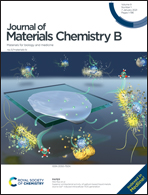A sensitive fluorescent probe for β-galactosidase activity detection and application in ovarian tumor imaging†
Abstract
The development of non-invasive and sensitive optical probes for in vivo bioimaging of cancer-related enzymes is desirable for early diagnosis and effective cancer therapy. β-galactosidase (β-gal) is regarded as a key ovarian cancer biomarker, owing to its overexpression in primary ovarian cancer. Herein, we designed a sensitive near-infrared (NIR) probe (DCMCA-βgal) for the detection and real-time imaging of β-gal activity in ovarian tumors, thereby achieving the visualization of ovarian tumors by β-gal activity detection. DCMCA-β-gal could be triggered by β-gal, resulting in the release of a NIR chromophore, DCM-NH2; the linear range of fluorescent response to β-gal concentration was 0–1.2 U with a low detection limit of 1.26 × 10−3 U mL−1. We used DCMCA-β-gal to detect and visualize β-gal activity in SKOV3 human ovarian cancer cells, as well as for real-time imaging of β-gal activity in ovarian cancer mouse models. DCMCA-β-gal possessed high sensitivity, “turn-on” NIR emission, a large spectral shift, and high photostability in a dynamic living system and thus could serve as a highly sensitive sensor for real-time tracking of β-gal activity in vivo and ovarian tumor imaging.



 Please wait while we load your content...
Please wait while we load your content...